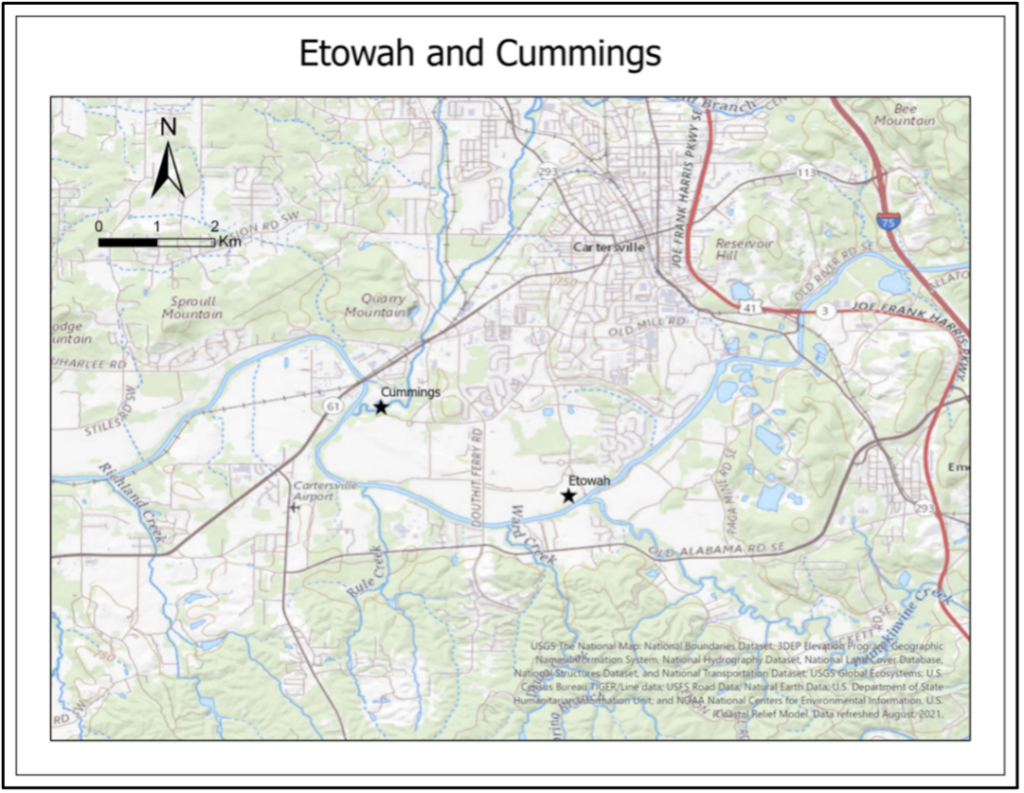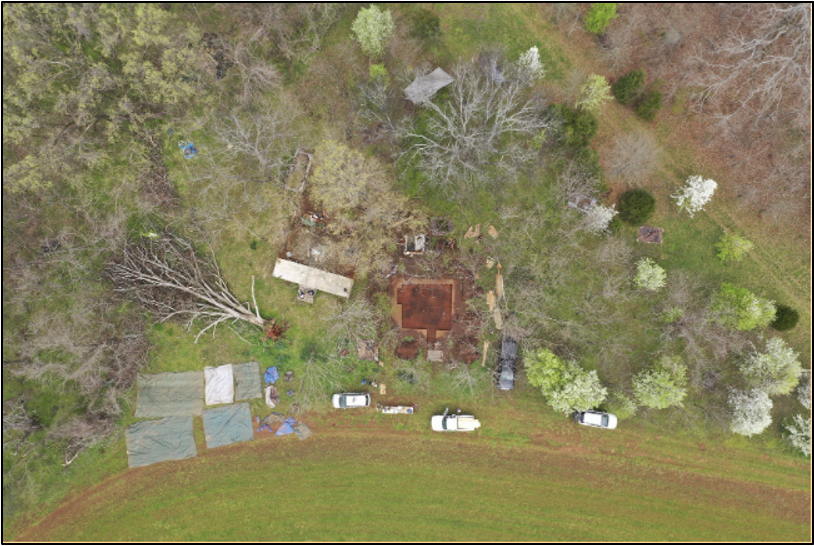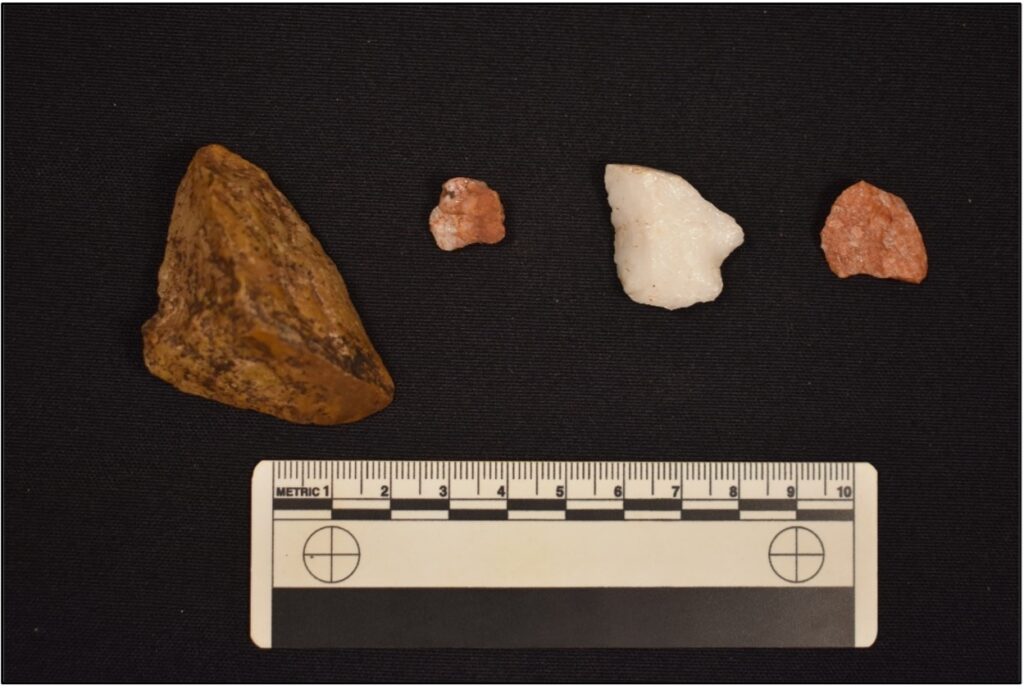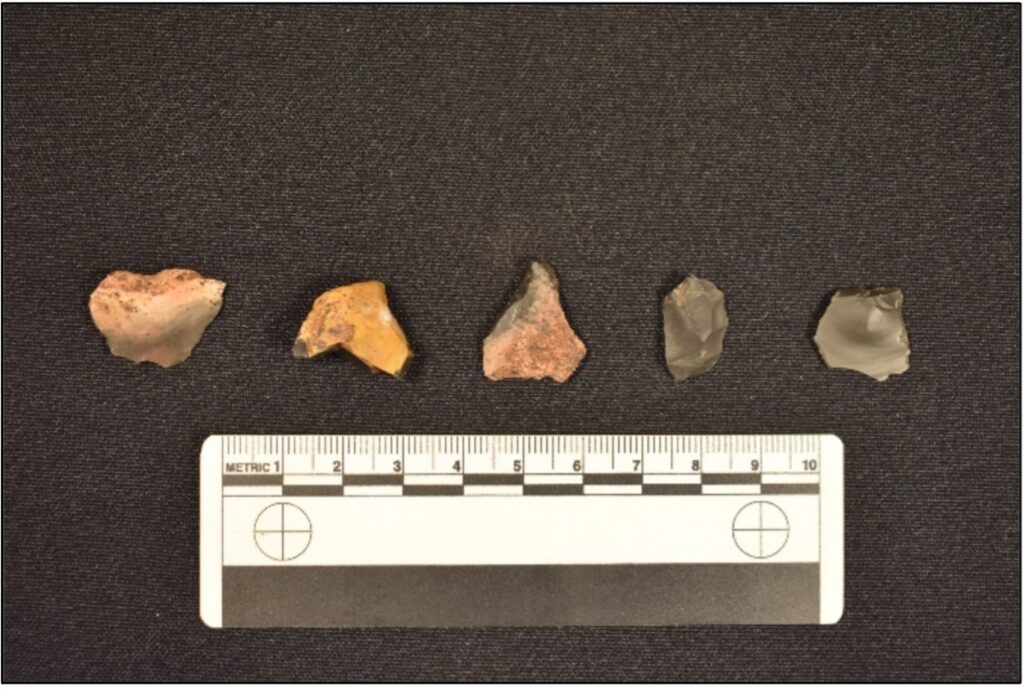John Tomko
Practicum in Anthropology
Dr. Terry G. Powis
May 9, 2022
Abstract
The Mississippian Period refers to the North American Southeast region and dates from AD 1000-1500. It is characterized by its societal organization, form of government, culture, and subsistence practices. Daily life and survival for the Native Americans in the Mississippian Period was dependent on lithics, and as such a wide variety of lithic artifacts appear in the archaeological record at this time. It also had its own network of lithics trade, which lent itself to the creation of workshops and specialists who produced tools for a wide range of sites within the Southeast. Workshops are loosely defined as locations with a significant amount of debitage or waste material. Workshops vary in size depending on the relative size of the settlement they are associated with. A major settlement such as Etowah may have a workshop with thousands and thousands of pieces of debitage, while smaller settlements may only have had hundreds of pieces. The lithics from the Cummings site, a Mississippian site located in Bartow County, Georgia will be evaluated with the aforementioned factors that contributed towards the identification of a workshop. This research looks to identify the presence of a workshop at the Cummings site, and in the absence of one, to see how exactly the lithics were being utilized at the site.
Introduction
The focus of this research is to analyze and identify a possible workshop at the Cummings site through the analysis of the lithic artifacts recovered during excavation. The Cummings site has been the location of an archaeological field school lead by Dr. Terry Powis of Kennesaw State University (KSU) for multiple years and has undergone all phases of excavation during this time. These phases consist of Phases I, II and III. Phase I is the undertaking of pedestrian survey and shovel testing, Phase II is the excavation of units and identification of features, and Phase III is feature excavation. From these excavations, a Middle Mississippian Period house was discovered, though it is not the focus of this research. The lithics studied and examined for this research come from the units dug during Phase II of the 2018 field school. These units were excavated in the northern portion of the site, about 30 meters away from the house itself. The purpose of examining the lithic material found in these units is whether there is sufficient information to designate this loci as an area of tool and weapon production. Other sites are used for comparative purposes, including the Mill Creek Locality in Southwestern Illinois.
Background
Mississippian Period
The Mississippian Period signifies the North American Southeast region from AD 1000-1500. This period is distinct in its social hierarchy, subsistence practices, material culture, and its architecture when compared to the time periods before and after it. The Mississippian Period itself consists of three sub-periods: the Early Mississippian (AD 1000-1200), Middle Mississippian (AD 1200-1375), and Late Mississippian (AD 1375-1500). The Middle Mississippian Period is considered to be the peak of the overarching period, and witnessed the expansion of chiefdoms and an increase in urban life. The Mississippian Period was discovered in the archaeological record by a number of unique attributes, including the rigorous cultivation of maize, settlements focused on floodplains of major rivers, shell-tempered pottery, rectangular wall-trench structures, pyramidal earthen mounds, and the long-distance trade of prestige items (Lewis et al. 2012, 21). Most importantly, the Mississippian Period would yield the emergence of a ranked society. This society would take the form of a chiefdom, a system in which social inequalities are informal and de facto but present nonetheless (Cobb 2020). It is commonly believed that chiefdoms began developing during this period as a response to increased agricultural yields and higher populations, factors facilitating the need for new decision making systems in which a hierarchy would function. This system, the chiefdom, would vary in size and complexity itself, with anthropologist Henry Wright creating the categories of “simple” and “complex” chiefdoms (Lewis et al. 2012, 26). Simple chiefdoms are chiefdoms that only have one level of hierarchy in place over the community, while complex chiefdoms have an entire group of elite individuals. Elites within a complex chiefdom compete with one another for political power, while simultaneously work to exclude non-elites. The larger the chiefdom the more necessity for more administrators, and as such more competition between elites. The constant competition between elites causes instability and a fluctuation between one and two levels of hierarchy (Lewis et al. 2012, 27). The research completed on chiefdoms has identified paramount chiefdoms as a form of complex chiefdom. Paramount chiefdoms encompass many simple as well as complex chiefdoms into a single polity and can occupy vast areas.
The Mississippian Period is also marked by trade between all forms of settlements, from paramount chiefdoms to villages, with foreign items being a critical vehicle for all kinds of local transactions (Brown et al. 1990, 1-8). Two of the major trade theories for the Mississippian Period are the Service Model and the Prestige Goods Economy Model. The Service model states that foreign relations and outside trade are administrative functions that require centralization for success. The increase in population caused by newer and more intensive maize agriculture increases the risk of conflict between settlements and as such creates a need for coordination with foreign affairs. The Prestige Goods Economy Model states that exotic goods are introduced through foreign trade, and these exotic goods validate and reinforce elite status for those who acquire them. This status, which holds the ability to facilitate external trade, attracts gifts and rewards itself, as long-distance external trade is held in such high regard. Elites that possess this status can leverage it to extract gifts and tribute. This bolsters the elites as they can trade externally and filter the goods coming into the settlement, keeping any goods of prestige, while providing the local settlement with what it needs (Dye 1995, 289).
The trade undergone during the Mississippian Period includes lithic tools as well as the aforementioned prestigious goods. Prestigious goods have been the focus of much research into Mississippian trade, but this trade fails to account for the utilitarian and mundane items such as stone hoes for example. Stone hoes have been studied and discovered to be more commonly found than prestige items (Cobb 1989, 79-92).
Etowah Site
Etowah is a large mound center located in northwestern Georgia and is one of the most prominent Mississippian Period mound centers of the Southeast. Etowah consists of six mounds, one of which is among the largest ever built in North America, two open plazas, encircled by a considerable defensive ditch (King 2001, 1-17). As seen in Figure 1 the Etowah site is located directly next to the Etowah River, and as such had easy access to all of the resources provided by it including potable water, food, transportation, among others. The site has undergone a series of excavations to learn more about how prehistoric people had lived there (Lewis 2021).
As shown by the archaeological record as well as the massive structures still remaining today the Etowah site was incredibly important during the Middle Mississippian Period, and as such impacted the region on a political as well as cultural level. This position of power and authority allowed Etowah to trade with many other settlements of different size and scale, and it is very likely one of these communities was the Cummings site.

Cummings Site
The Cummings site is a Middle Mississippian site located in Cartersville, Georgia, situated roughly 100 meters to the south of Pettit Creek (Powis et al. 2021). The Etowah River is about 500 meters to the west of the site, with the Etowah Indian Mounds being three kilometers to the Southeast. Associated with the Cummings site is an historic house from the early 20th century with the foundation and chimney still standing. The house was once occupied by Charlie Adams and his family, who were tenant farmers. Shovel tests and units undertaken across the Cummings site has yielded such historic artifacts as pottery, glass, bricks, and nails.
The most prominent feature at Cummings is a house that is mere meters away from the Adams house foundation. This Middle Mississippian house burned down, and has been dated radiometrically to AD 1260-1300. The burned floor is distinct in its dark color and can be seen clearly from this drone image (see Figure 2). A number of artifacts were found on the house floor, including pottery, stone celts, a stone palette, a spatula, styluses, uncut mica fragments, and other miscellaneous objects. The presence of the flat stones, styluses, and mica have led to a discussion as to whether the inhabitants of the house may have been artisans (James 2022). Interestingly enough, no lithic debitage flakes was found to indicate that stone-working was being conducted in the house. The overwhelming majority of the lithic material from the site comes from the 2018 excavation units, not from the house itself.

Lithic Tool Production
Lithic tool production was a common occurrence during the Mississippian Period. Stone tools were essential to daily life, and the production and upkeep of them was a necessity. The raw material used for tools varied between sites as did access to high quality materials. Lithic tool production begins with the raw material extracted from the earth, whether this is chert, quartz, or another mineral. Once the raw material is collected a flintknapper begins to strike the material with a hammer stone (a rounded stone of hard material), knocking material off as they go along. This is done with the intent of a final product in mind, whether it is a hoe, a projectile point, a knife, or a combination of a point and knife (i.e. projectile point/knife or PPK). After a considerable amount of material has been struck off, but the tool has not yet been completed, the stone is referred to as a preform, as it has been prepared but not fully completed in its shaping.
There are also two sets of classification for lithic tools themselves, formal and informal. Formal tools are tools that have undergone the entire lithic tool production process, and whose form directly shows their function, this includes PPK’s and hoes. Informal tools are tools made from debitage, such as flakes, and are simply retouched on their edges for the purpose of an easy and quick tool that may not be explicitly clear in its shape, like a scraper or simple blade. The informal tools in this research are identified as retouched flakes, as they exhibit intentional retouching on their edges (Rozen et al. 1989, 179-184).
The actual process of lithic tool production, flint knapping, creates lithic debitage, or waste, and it is through this debitage that archaeologists are able to examine the scale of production between sites. There are multiple classifications of debitage, flakes, shatter, and tertiary fragments, as labeled in this research. Flakes are pieces of chert that have been directly struck off by a hammer stone. They are characterized by a striking platform and a bulb of percussion. These characteristics are caused by the direct striking of a hammer stone in the flint-knapping process, as the striking platform has been deformed by being struck, and the bulb of percussion has been caused by the force of impact from the hammerstone rippling through the stone. Flakes are distinct from shatter, as shatter is the result of stone indirectly breaking off when struck. Shatter has no discernable striking platform or bulb of percussion, as it breaks off as a result of an indirect strike. Shatter has been divided into clear quartz shatter, and regular shatter in this research. Clear quartz shatter is shatter that is very crystalline quartz and of a high quality for lithic tools, and was documented for the context of quartz tool production, while shatter simply refers to chert shatter. The aforementioned tertiary fragments are a classification used in this research to refer to flake fragments that are broken and missing the striking platform and bulb of percussion, but also lack any cortex. This classification was created to provide extra context, as they are indicative of the stages of lithic production, and they are discernible from shatter.
Analyzing the tool production process allows archaeologists to examine debitage and evaluate what stages of the process are undergone at different settlements. This research focused on the amount of cortex, the outer surface of a stone that makes up the exterior, that was left on debitage to see what stages of production were completed. Looking at the amount of cortex found on flakes, one of the byproducts of flint-knapping, one can see how early into the process the tool production was. The more cortex on the flake the earlier into the process, and the less cortex on a flake the later into the process. Using this system flakes are divided into three categories based off of how much cortex is found on them: primary, secondary, and tertiary (see Figure 3. Primary flakes possess an entire surface of cortex. Secondary flakes include flakes that possess any cortex at all that doesn’t cover an entire surface. Lastly, tertiary flakes include all flakes that don’t possess any cortex. Fire cracked rock is a type of quartz that has been heated by a fire until bursting open, this material, while cultural, is not a part of the lithic tool production process, and was not taken into account in this research. Another classification seen in lithic analysis is biface, a core or flake that has been worked on all edges to create a shape with two sides (Rozen et al. 1989, 179-184).

Methodology
The material analyzed for this research was collected in 2018 from six units excavated in the northern part of the Cummings site, as seen in Figure 2. The artifacts from these units were taken and then transferred to the lab where they were cleaned and put into bags for storage. From these bags, all of the lithic material was separated from the non-lithic material, this included separating natural stone from cultural as well as separating fire cracked rock from clear quartz shatter and quartz flakes.
Once this was done the cultural material was further sorted into chert and quartz categories. When separating the chert and quartz there were three original divisions, chert, quartz, and clear quartz, this was done to make the process as simple as possible. Within these categories the lithics were divided into the categories of flakes, preforms, retouched flakes, PPK’s, shatter, and tertiary fragments. PPK’s and preforms were each given their own bags and catalogue numbers, and stayed divided between the overarching chert and quartz divisions. Next chert and quartz flakes were divided into their categories of primary, secondary, and tertiary. After making these divisions the chert and quartz formal tools, or PPK’s as well as flakes, were divided between complete and broken. Flakes and PPK’s were considered broken if the distal end were broken or chipped in any way. The length of PPK’s and flakes is diagnostic and as such if the distal end is broken, they lose context.
After all of the respective categories were established and the lithic material divided among these categories all of the material was input into a Microsoft Excel datasheet. Within this datasheet the lithics were documented by date, unit, level, and provenience number. After this was done the best samples of each category were taken and photographed with a scale for documentation. Photo documentation was done in the KSU Anthropology Lab on a photo stand with four lights affixed to it. Quartz flakes were separated for photo documentation, as well as chert flakes (see Figures 3 and 4). The preforms and PPK’s, chert and quartz, were photographed together. Chert and quartz Broken PPK’s were also grouped together for photos.

Results
The lithic assemblage totaled 2,496 pieces. This number includes all pieces of shatter, tertiary fragments, PPK’s, preforms, and categories of flakes. The total number of tertiary fragments is 1,231, and the total number of chert shatter is 564. The clear quartz shatter total is only 66, much less than the chert shatter. The total number of all chert flakes is 567, out of these 417 are broken tertiary, and 115 are complete tertiary. The remaining includes 22 broken secondary, nine complete secondary, one broken primary, and three primary complete flakes. The Quartz flakes are much lower in number, totaling at 134. Out of the 134 total, 85 are tertiary broken, 47 are tertiary complete, one is secondary broken, and one is secondary complete.
There is a total of six preforms, five of which are chert with one being quartz. There are 11 expedient tools, or retouched flakes, all of which are chert. There are also 12 formal tools, or PPK’s, out of which nine are chert and three are quartz. A majority of each type of PPK are broken with eight of the chert ones broken and two of the quartz broken as well. Listed below in Table 1 are the totals for each tool divided between quartz and chert.
Results
The lithic assemblage totaled 2,496 pieces. This number includes all pieces of shatter, tertiary fragments, PPK’s, preforms, and categories of flakes. The total number of tertiary fragments is 1,231, and the total number of chert shatter is 564. The clear quartz shatter total is only 66, much less than the chert shatter. The total number of all chert flakes is 567, out of these 417 are broken tertiary, and 115 are complete tertiary. The remaining includes 22 broken secondary, nine complete secondary, one broken primary, and three primary complete flakes. The Quartz flakes are much lower in number, totaling at 134. Out of the 134 total, 85 are tertiary broken, 47 are tertiary complete, one is secondary broken, and one is secondary complete.
There is a total of six preforms, five of which are chert with one being quartz. There are 11 expedient tools, or retouched flakes, all of which are chert. There are also 12 formal tools, or PPK’s, out of which nine are chert and three are quartz. A majority of each type of PPK are broken with eight of the chert ones broken and two of the quartz broken as well. Listed below in Table 1 are the totals for each tool divided between quartz and chert.

Discussion
Mississippian Period workshops have been few and far between, with some of the most prominent results stemming from the Mill Creek locality quarries in Illinois. The Mill Creek quarries and workshops provide a precedent of smaller settlements engaging in some level of specialization in craft production. The relationship between the smaller workshops and quarries of Mill Creek and Hale may be comparative to the relationship of Cummings and Etowah. Etowah was much larger than Hale in its prime and would have definitely been in contact with Cummings, as they are in such close proximity. The question arises about the scale of production that would be needed at Cummings for it to have been contributing lithics to Etowah through trade. The aforementioned Mill Creek quarries, for example, produced a minimum of approximately 200 hoes yearly (Cobb 1989, 79-92). Cummings, on its own, does not have a large amount of lithic material, or any evidence of it being the site of a quarry.
The Mill Creek Locality consists of Mississippian Period quarries and workshops located at the intersection of Union, Pulaski, and Alexander counties in Southwestern Illinois (Cobb 1989, 79-92). These sites have been linked to the production of Mill Creek chert bifaces, worked bifaces that became a part of both intraregional and interregional trade. Many of the quarries and workshops in the Mill Creek locality are smaller in size, with only two mound centers located in the area. One of the mound centers is the Hale site, located on a ridge in a small floodplain in the upland region (Cobb 1989, 79-92). The Hale site is roughly located between the two major quarries of the region. The Hale site itself is not large when compared to other Mississippian mound centers, possessing only two smaller mounds. Within the Hale site there is also a deep midden, that provides evidence of rigorous production of lithic digging tools. The location of the site, the mounds, and the large midden found at Hale implies that it may have been trying to control lithic trade to the surrounding area (Cobb 1989, 79-92). The smaller quarries and workshops near the Hale site give an example of smaller settlements engaging in lithic production for nearby larger mound settlements. Though it is important to note that the Hale site itself also engaged in lithic production.
The current view of the inhabitants of Cummings is that they were farmers and may have been artisans, with celts used for plowing and art production materials found in the excavated house (James 2022; McElrone 2022). Debitage from lithic tool production has been found in units dug away from the house, with no pieces found within. The units excavated for this research, in the northern area of the site, were tens of meters away, lending credence to a possible designated area for lithic tool production. However, the actual pieces of debitage found in the excavated units are heavily skewed to be tertiary in nature, with very few primary and secondary flakes being recovered. The lack of primary and secondary flakes infers that the early stages of tool production were not present at the site. This leaves two possible options for what was undergone at the site: the first, that there was the retouching of tools but no significant tool production; and the second, that the site was receiving preforms through trade, and shaping the preforms into finished products themselves.
The possibility of Cummings receiving chert preforms through trade is fairly high, as it shares close proximity with Etowah, and a vast majority of the lithic material from the site is chert. Without the presence of trade in the area Cummings would have most likely used more quartz in their tool production out of necessity, rather than the large amount of chert they actually utilized. The seemingly designated area for lithic production, meters away from the house itself, supports the theory that the site may have received preforms and shaped them on their own. It should be noted that there aren’t many sources provided for the trading of chert preforms rather than bifaces or tools, though this could be accounted for by a lack of focus on utilitarian goods in Mississippian Period trade, and more of a skew towards cultural and prestigious goods.
The opposing idea to Cummings receiving and shaping preforms is that they received chert bifaces through trade, and simply retouched and rejuvenate them. This theory bodes well with the low total of debitage found at Cummings compared to Mills Creek sites. The currently held belief that the inhabitants of Cummings were farmers also supports the theory of Cummings trading and receiving bifaces. A smaller settlement, consisting of farmers, would most likely not have the level of craft specialization needed to have a workshop and to maintain full-time lithic production.
Further Research
Though lithic tools have been researched extensively from the Mississippian Period, there is a distinct lack of research into lithic workshops and trade. Research into Mississippian Period trade has been somewhat focused on the trade of prestigious goods and not on more utilitarian goods such as lithic tools (Koldehoff et al. 2010, 131-164). Researchers have often collected and counted lithic debitage, but have somewhat missed the larger picture of regional lithic trade, except in the case of hoe bifaces (Cobb 1989). By looking into all of the debitage and lithics found at a site, future research may be able to find patterns of raw material procurement (Koldehoff et al. 2010, 131-164). The definition of a workshop has also been unclear in Mississippian Period research, leaving much to be desired for those attempting to research them. Of course, it would also be incredibly beneficial to have more excavated Middle Mississippian Period houses, as they could provide more context for day-to-day lithic tool maintenance.
Conclusions
There are many conclusions to be made after taking the findings of the research into consideration. The amount of lithic material is to be taken into account, as this may indicate the scale of lithic production located at the site, as well as the presence of a workshop. The aforementioned total number of lithic material is 2,591. This number is somewhat low, as knapping performed in the lab yielded 322 pieces of debitage for the creation of one PPK. This knapping was also done from a preform, not an entire cobble, which would yield even more pieces of debitage. Applying this number as a rough estimate for the amount of debitage made from a single PPK we can infer that the debitage from the site could be representative of only seven to eight PPKs, even after taking into account the shaping of preforms received through trade. Even after accounting for a margin of error, such a low total of debitage would insinuate that there is not a workshop for lithic production at the site.
The Cummings site was likely receiving bifaces or other lithic tools through trade and simply maintaining them. This trading would have been between the prominent Etowah site and Cummings, in which the former would have provided chert tools in the place of quartz. This would align well with the findings, in which chert is used at a significantly higher rate than quartz at the site. The trade of completed bifaces and chert tools tracks well with the fact that there is staggeringly more tertiary material than any other material, including shatter. With Cummings simply trading for tools they would have little to no evidence of early stages of lithic production, such as primary and secondary flakes.
While the separate location used for lithic production may seem relevant, it is likely that the inhabitants of Cummings used the area to avoid trampling on debitage in their homes. The inhabitants of Cummings also appear to be farmers in practice, and would be preoccupied with farming and possibly providing Etowah with a crop tribute to be specialized lithic craftspeople. Etowah, having power and authority over a considerable area, could have traded with any number of settlements for their lithic tool needs. This would be logical as they could reach out to larger settlements as well as settlements with high quality chert quarries.
Altogether Cummings lacks a number of attributes that are needed for a workshop. Cummings has a low total number of lithic debitage, in which even after accounting for the knapping of preforms would only account for roughly eight PPK’s. Cummings also lacks evidence for all stages of lithic production, yielding only four primary chert flakes, and 31 secondary chert flakes, with no primary quartz flakes. In addition to this there is the evidence of the inhabitants of Cummings engaging in separate subsistence practices, such as farming and possibly art production (James 2022). The Cummings site fails to fulfill the criteria needed for a workshop, and lithic tool production at the site was more than likely the simple maintenance of tools received through trade.
Acknowledgements
This research was supported and aided by Dr. Terry Powis, Carl Etheridge, Isabella Rosinko, and the Kennesaw State Department of Anthropology and Geography. Dr. Powis provided access to the lithic material analyzed, the photography equipment used for the pictures, as well as assistance and guidance in the research. Carl Etheridge provided the experimental knapping used in the research. Isabella Rosinko helped in the organization of the lithic material in the lab. The Kennesaw State University Department of Anthropology and Geography provided the lab space and opportunity for research.
Bibliography
King, Adam
2001 Long-Term Histories of Mississippian Centers: The Developmental Sequence of Etowah and Its Comparison to Moundville and Cahokia. Southeastern Archaeology 20, no. 1 (2001): 1–17.
Brown, James A., Richard A. Kerber, and Howard D. Winters. “Trade and the Evolution of Exchange Relations at the Beginning of the Mississippian Period.” The Mississippian Emergence 1-8 (1990).
Cobb, Charles R. “AN APPRAISAL OF THE ROLE OF MILL CREEK CHERT HOES IN MISSISSIPPIAN EXCHANGE SYSTEMS.” Southeastern Archaeology 8, no. 2 (1989): 79–92. http://www.jstor.org/stable/40712905.
Cobb, James and John Inscoe. “Georgia History.” New Georgia Encyclopedia, last modified Sep 30, 2020. https://www.georgiaencyclopedia.org/articles/history-archaeology/georgia-history-overview/
Dye, David H. “Mississippian Warfare and Prestige-Goods.” Native American interactions: Multiscalar analyses and interpretations in the Eastern Woodlands (1995): 289.
Koldehoff, Brad, and Tamira Brennan. “Exploring Mississippian Polity Interaction and Craft Specialization with Ozarks Chipped-Stone Resources.” Missouri Archaeologist 71 (2010): 131-164.
Larson, Lewis. “Etowah Mounds.” New Georgia Encyclopedia, last modified Oct 13, 2021. https://www.georgiaencyclopedia.org/articles/history-archaeology/etowah-mounds/
McElrone, Devlin 2022 House of Rock: An Analysis of a Lithic Assemblage from an Early Wilbanks Phase House Floor. Poster presented at the annual Symposium of Student Scholars, Center for Teaching and Excellence, Kennesaw State University, April 19.
Powis, Terry G., Jordan Farkas, Carl Etheridge, Kong Cheong, and Adam King 2021 The Cummings Site; Life on the Outskirts of Etowah. Paper presented at the 77th annual meeting of the Southeastern Archaeological Conference, Durham, NC, Oct. 26.
Rozen, Kenneth C., and Alan P. Sullivan. “The Nature of Lithic Reduction and Lithic Analysis: Stage Typologies Revisited.” American Antiquity 54, no. 1 (1989): 179-184.
